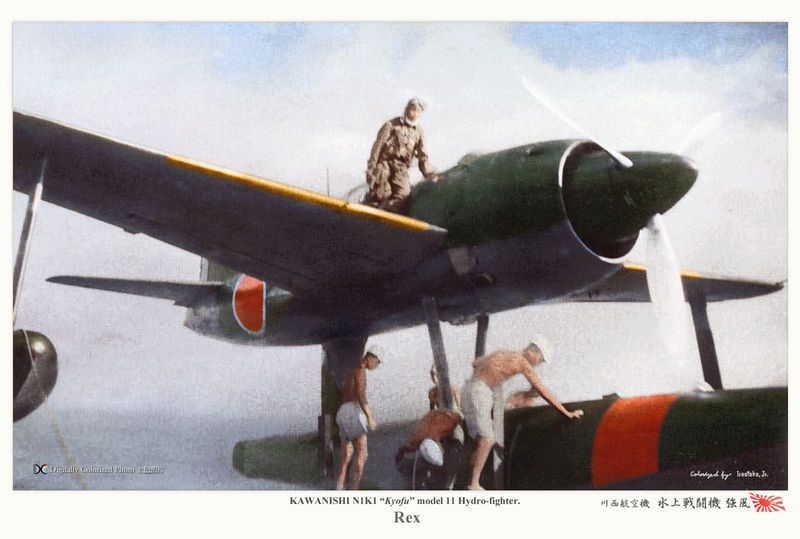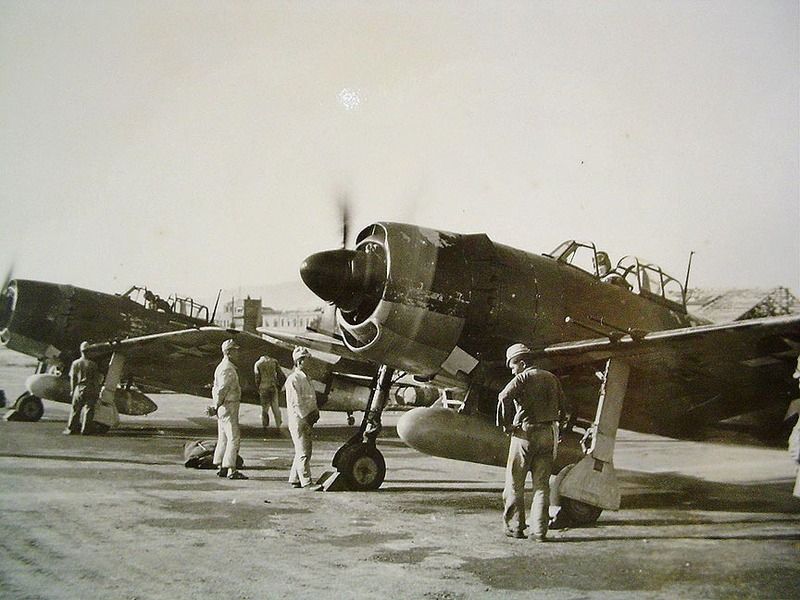Wed Dec 01, 2004 9:46 am
Don Martin wrote:Sure Scott,
we'll hang a pair of Floats on a 17 and sling a couple of torpedos underneath. That would make it a TBB-17A Flying Torpedo, right!

Take the ball turret out and elongate the bomb bay, could probably stack 2 torps on each side of the catwalk
Re: Me 109 W-1 ( on floats )
Wed Dec 01, 2004 10:49 am
Juke wrote:Is this a true project or just hoax ?
Juke
One one...
divetheworld !
Weekend Home Work
Sat Dec 04, 2004 3:54 pm
With out a lot of thought the Floatplane fighter that was turned into a front line fighter was a Japanese plane the Ki-64 I think. But even before that and with better certanty I would say that the A6M! It was first developed for floats that is one reason for its great range.
AS for the 4F4 on floats I hope you mean the USS Yorktown
AS for the 4F4 on floats I hope you mean the USS Yorktown
Re: Me 109 W-1 ( on floats )
Wed Jun 15, 2016 5:29 pm
Always fun to revive some of these old threads ...
Messerschmitt Bf 109W
"In 1941 Messerschmitt was asked by the RLM to research the possibility of creating a floatplane fighter based on the 109. The company choose the F-series as its basis for this design and added floats from a Arado Ar-196. It is believed nothing came of this idea and it was abandoned. A float equipped 109 would have been very heavy and cumbersome and would have been no match for land based fighters. The same experience was made by the British with their Spitfire floatplane and the Japanese with the Zero floatplane fighter."

... and here's some photos of other types that are familiar yet didn't really amount to much ...
Grumman F4F-3S Wildcatfish
Due to the successful use of fighter seaplanes by Japanese forces in the Pacific, in 1942 Grumman experimented with a new development of its F4F-3 Wildcat, in the creation of a floatplane version of this fighter. The conversion of a standard production aircraft was undertaken by Edo Corporation in the space of three months from the Navy request being made; the floats themselves were specially designed for the "Wild Catfish", as this prototype became known, and the entire airframe was subjected to stress analysis and some strengthening. To compensate for the decreased yaw stability resulting from the extra side area of the floats forward of the aircraft center of gravity, additional rudder area was required, and this was provided by fitting small additional surfaces at the tips of the tailplane, with an interconnection with the main rudder. The F4F-3 floatplane, sometimes referred to as the F4F-3S, first flew on February 28, 1943 and under Navy contract Edo provided 100 sets of floats in great haste, but the changing nature of the war in the Pacific made it unnecessary to proceed with further floatplane conversions, and the project was canceled.

Grumman F4F-3S Wildcatfish

Grumman F4F-3S Wildcatfish
Curtiss XSB2C-2
Production float plane version, 287 cancelled and not built.

Curtiss XSB2C-2 floatplane in 1942

Curtiss XSB2C-2 floatplane in 1942
Supermarine Spitfire Mk. Vb floatplane
"Having been originally developed from the Supermarine S6B it is perhaps natural that the Spitfire should be developed for use on water.
The first Spitfire floatplane was a conversion of a Mark I, the so called "Narvik Nightmare" R6722 which was produced at the time of the German invasion of Norway where there emerged a requirement for a fighter capable of flying from the Fjords in view of the lack of suitable airfields in the country.
In the interests of speed, floats from a Blackburn Roc were fitted but the trials were not successful and as the campaign for which the conversion was required was rapidly drawing to a close the project was suspended.
The idea was revived again with the beginning of the war in the Pacific against Japan when it was realized that a floatplane fighter with good performance would be an essential asset in the island campaigns which seemed likely.
Folland Aircraft undertook the conversion of a Spitfire Mk Vb, W3760, with Supermarine designed floats and this aircraft proved an immediate success with a top speed of 324 mph. In this aircraft the carburetor air intake was extended to avoid spray, a shorter four blade propeller was fitted, cantilever pylons attached the floats to the inboard wing sections, a ventral fin replaced the tail wheel and the fin was extended slightly forward to increase the vertical tail surface area.
Mark V conversion (Original Fin)
Folland built several sets of floats and converted another two Mark V aircraft, EP751 and EP754. These together with W3760 were shipped to Egypt in 1943 and assembled with the intention of covertly operating them out of small Greek islands to intercept German transport aircraft"

Supermarine Spitfire Mk. Vb EP751

Supermarine Spitfire Mk. Vb EP751
Douglas XC-47C
"The Douglas XC-47C was a floatplane producing by fitting Edo Model 78 floats to a standard C-47. The prototype, with a 1942 serial number and powered by two Pratt & Whitney R-1830-92 Twin Wasp engines, handled well in the air, although could carry less cargo than the standard C-47. The single-step metal floats contained retractable wheels, located at the step, allowing the XC-47C to operate on land, but the tyres were prone to fail. The biggest problem with the XC-47C was that it could only operate on smooth water, greatly limiting its usefulness. Despite this 150 sets of floats were ordered from Edo, and the C-47C saw limited service in New Guinea and Alaska (where smooth water must have been in very short supply)."

Douglas XC-47C experimental transport aircraft, Jamaica bay, New York, United States, 13 Nov 1943
... and a nicely designed IJN flotaplane.
Kawanishi N1K1 Kyofu

Kawanishi N1K1 Kyofu at Willow Grove Naval Air Station in the late 1940s or 1950s
there's plenty of other examples as well.
Messerschmitt Bf 109W
"In 1941 Messerschmitt was asked by the RLM to research the possibility of creating a floatplane fighter based on the 109. The company choose the F-series as its basis for this design and added floats from a Arado Ar-196. It is believed nothing came of this idea and it was abandoned. A float equipped 109 would have been very heavy and cumbersome and would have been no match for land based fighters. The same experience was made by the British with their Spitfire floatplane and the Japanese with the Zero floatplane fighter."

... and here's some photos of other types that are familiar yet didn't really amount to much ...
Grumman F4F-3S Wildcatfish
Due to the successful use of fighter seaplanes by Japanese forces in the Pacific, in 1942 Grumman experimented with a new development of its F4F-3 Wildcat, in the creation of a floatplane version of this fighter. The conversion of a standard production aircraft was undertaken by Edo Corporation in the space of three months from the Navy request being made; the floats themselves were specially designed for the "Wild Catfish", as this prototype became known, and the entire airframe was subjected to stress analysis and some strengthening. To compensate for the decreased yaw stability resulting from the extra side area of the floats forward of the aircraft center of gravity, additional rudder area was required, and this was provided by fitting small additional surfaces at the tips of the tailplane, with an interconnection with the main rudder. The F4F-3 floatplane, sometimes referred to as the F4F-3S, first flew on February 28, 1943 and under Navy contract Edo provided 100 sets of floats in great haste, but the changing nature of the war in the Pacific made it unnecessary to proceed with further floatplane conversions, and the project was canceled.

Grumman F4F-3S Wildcatfish

Grumman F4F-3S Wildcatfish
Curtiss XSB2C-2
Production float plane version, 287 cancelled and not built.

Curtiss XSB2C-2 floatplane in 1942

Curtiss XSB2C-2 floatplane in 1942
Supermarine Spitfire Mk. Vb floatplane
"Having been originally developed from the Supermarine S6B it is perhaps natural that the Spitfire should be developed for use on water.
The first Spitfire floatplane was a conversion of a Mark I, the so called "Narvik Nightmare" R6722 which was produced at the time of the German invasion of Norway where there emerged a requirement for a fighter capable of flying from the Fjords in view of the lack of suitable airfields in the country.
In the interests of speed, floats from a Blackburn Roc were fitted but the trials were not successful and as the campaign for which the conversion was required was rapidly drawing to a close the project was suspended.
The idea was revived again with the beginning of the war in the Pacific against Japan when it was realized that a floatplane fighter with good performance would be an essential asset in the island campaigns which seemed likely.
Folland Aircraft undertook the conversion of a Spitfire Mk Vb, W3760, with Supermarine designed floats and this aircraft proved an immediate success with a top speed of 324 mph. In this aircraft the carburetor air intake was extended to avoid spray, a shorter four blade propeller was fitted, cantilever pylons attached the floats to the inboard wing sections, a ventral fin replaced the tail wheel and the fin was extended slightly forward to increase the vertical tail surface area.
Mark V conversion (Original Fin)
Folland built several sets of floats and converted another two Mark V aircraft, EP751 and EP754. These together with W3760 were shipped to Egypt in 1943 and assembled with the intention of covertly operating them out of small Greek islands to intercept German transport aircraft"

Supermarine Spitfire Mk. Vb EP751

Supermarine Spitfire Mk. Vb EP751
Douglas XC-47C
"The Douglas XC-47C was a floatplane producing by fitting Edo Model 78 floats to a standard C-47. The prototype, with a 1942 serial number and powered by two Pratt & Whitney R-1830-92 Twin Wasp engines, handled well in the air, although could carry less cargo than the standard C-47. The single-step metal floats contained retractable wheels, located at the step, allowing the XC-47C to operate on land, but the tyres were prone to fail. The biggest problem with the XC-47C was that it could only operate on smooth water, greatly limiting its usefulness. Despite this 150 sets of floats were ordered from Edo, and the C-47C saw limited service in New Guinea and Alaska (where smooth water must have been in very short supply)."

Douglas XC-47C experimental transport aircraft, Jamaica bay, New York, United States, 13 Nov 1943
... and a nicely designed IJN flotaplane.
Kawanishi N1K1 Kyofu

Kawanishi N1K1 Kyofu at Willow Grove Naval Air Station in the late 1940s or 1950s
there's plenty of other examples as well.
Re: Me 109 W-1 ( on floats )
Wed Jun 15, 2016 6:41 pm
The old Folsom DC-3 below in a couple of the pics. Looking at the EDO floats in the various DC-3 pics above and below, it seems there are 3 versions of the rudders at the aft end of the floats. I see vertical, horizontal and one vert/one horizontal combo.
http://www.douglasdc3.com/float/float.htm
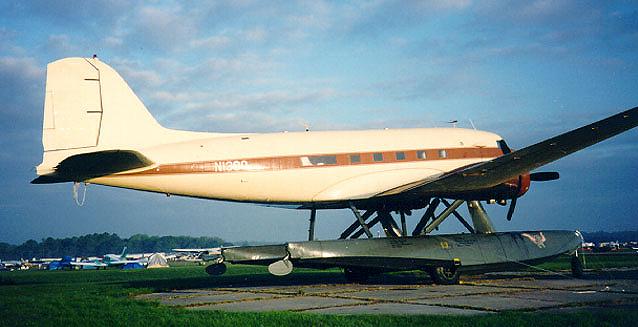
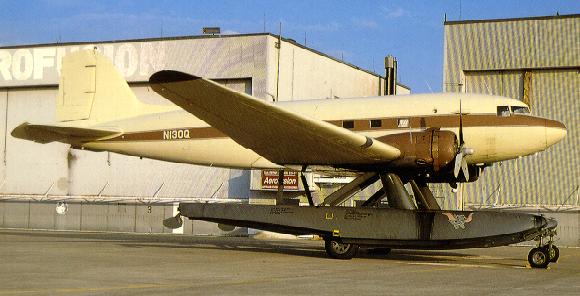
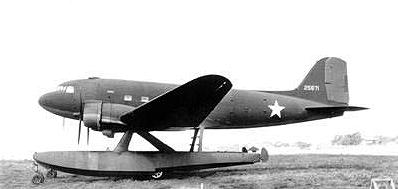
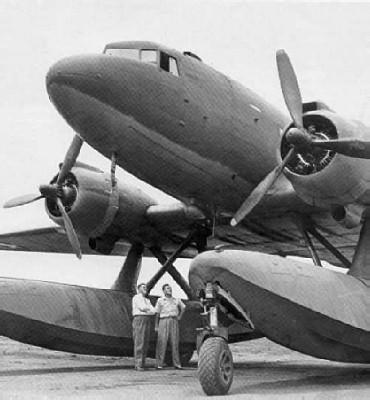
http://www.douglasdc3.com/float/float.htm




Re: Me 109 W-1 ( on floats )
Wed Jun 15, 2016 7:01 pm
CoastieJohn wrote:The old Folsom DC-3 below in a couple of the pics. Looking at the EDO floats in the various DC-3 pics above and below, it seems there are 3 versions of the rudders at the aft end of the floats. I see vertical, horizontal and one vert/one horizontal combo.
Looking at the shape of the rudders, I believe they are in 2 different position-up for flying and down for use in the water (as many float planes are equipped). If they were down all of the time, it seems very likely they would be damaged when landing on a runway with just a bit of tail down attitude.
Re: Me 109 W-1 ( on floats )
Wed Jun 15, 2016 7:31 pm
That's very possible and makes sense although the one up/one down config may need to be explained. I would think both up or both down....unless one of the springs is broken.
Re: Me 109 W-1 ( on floats )
Wed Jun 15, 2016 7:46 pm
I remember seeing just the floats in Greenville, Me.; they took up the whole hangar... 
Re: Me 109 W-1 ( on floats )
Thu Jun 16, 2016 8:41 am
